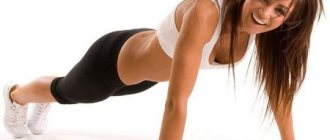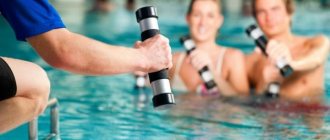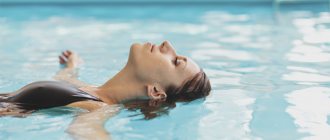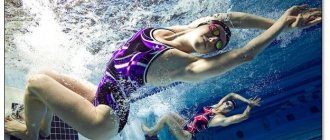In the distant past, plump women were considered the standard of beauty and great artists sought to capture them on their canvases. Nowadays, attitudes towards obesity have changed, as this problem is attributed to chronic diseases. A person is prone to developing this disease if he leads a sedentary lifestyle, eats poorly and has a genetic predisposition. In the latter case, it is very difficult to get rid of fat deposits and the habit of eating a lot. Some people tend to eat stress, or quietly eat a lot of high-calorie foods while watching TV or sitting at the computer.
It is known that with age, a person’s physical activity decreases, hormonal levels change and metabolism slows down, but the habit of eating in the same amount remains the same. There is secondary obesity, which occurs due to problems with the endocrine system, due to brain injury, or can develop as a result of taking certain medications (this occurs in only 5% of cases).
For many, fitness is an essential element of everyday life, as playing sports allows you to be active, energetic, young and healthy. If you are overweight, doing strength training is dangerous for your joints and bones, so swimming is the solution.
As a person ages, physical activity decreases
What are calories and calorie content
Calories provide the body with energy. Any food digested by the body is converted into calories. Their main sources are proteins, fats and carbohydrates. Nutrition should be given special attention. Carbohydrates, which provide energy to the body, are divided into fast and slow. Desserts, sweet pastries and fruit juice are among the champions of fast carbohydrates, causing a sharp jump in blood sugar, and easily turn into fat deposits, saturating the body for a short time. Slow carbohydrates, so-called side dishes, satiate the body for a long time and do not turn into extra centimeters on the waist. The calorie calculator will help you calculate your daily kilocalorie needs, select and create a menu.
Rules for “fat burning” swimming
To burn a lot of calories, you don't just need to do a lot of fast movements while swimming. There is a list of recommendations thanks to which you can exercise without doubting that the process of losing weight will go as quickly as you would like.
You get the most benefit from swimming if:
- Before each lesson, do a warm-up - smooth, calm exercises are quite suitable;
- breathe as experts advise for the chosen swimming style;
- do not eat food 2 hours before and after class;
- set breaks, allowing the body to rest;
- visit the pool at least three times a week;
- increase the intensity gradually;
- do not torment yourself with a diet close to starvation - according to some doctors, in this situation the body will try to conserve energy and, at the slightest opportunity, replenish deposits.
Swimming in the pool: how many calories does it burn?
How many calories are burned when running?
If you want to always be in shape, you need to swim. Thanks to swimming, you can improve your health, become strong, develop willpower and gain self-confidence. The ability to swim is a vital skill for every person; it brings invaluable benefits to the body. The water in the pool, being a powerful natural simulator, provides an even load on all muscles, has a positive effect on all body systems, increases the overall tone of the body and helps it relax. All muscles are worked out in the water, regardless of the chosen swimming style, which significantly improves muscle tone and makes them stronger. Due to the fact that the density of water is 12 times greater than the density of air, any movement in water requires more effort, thereby wasting a lot of energy, and training is much more effective.
During swimming, muscles alternately tense and relax, which increases their performance and strength. Swimming requires the coordination of all moving muscles, while the water supports the body so that no excessive stress is placed on any muscle group or joint. While swimming, joints and ligaments are in constant work. When a person makes circular movements with his hands in the water, the shoulder joints are strengthened, and when performing movements with the legs, the pelvic joints are strengthened. Swimming brings invaluable benefits to the spine, stretching the vertebrae, increasing mobility and improving flexibility of the neck, shoulder and hip joints. Swimming is also beneficial for people with varicose veins. You can burn up to 750 calories in an hour of swimming in the pool. Swimming in the pool, especially in the cold season, perfectly strengthens the body.
Swimming in the pool
Swimming lessons are especially beneficial for children, as, in addition to their beneficial effects on health, they develop character. Children who swim from an early age are less likely to experience colds, they are hardened, they also do not have problems with posture, they have a strong immune system, a good appetite and a restful sleep.
Factors affecting calorie expenditure
When swimming, a huge amount of calories is lost, but energy consumption directly depends on gender, swimming style, regularity and intensity of training, as well as the weight of the swimmer. If a water sport is chosen solely to improve health and relieve stress, it is necessary to select a comfortable mode and regularity of training. Even minimal exercise in water, reminiscent of unobtrusive childish floundering, invariably leads to a loss of calories and a slender, toned figure.
If swimming is chosen as a way to lose weight and form sculpted muscles, you need to thoroughly understand which style burns a certain amount of calories, what pace and duration of training lead to the greatest waste of energy. In order to get the maximum benefit from water exercise, it is better to contact a professional trainer who will calculate the correct regime for visiting the pool and the intensity of exercise.
Floor
At the same intensity and pace of training, men spend more kcal during swimming than women. This is most often due to the greater body weight and accelerated metabolism of the male body.
Swimming style
It is no secret that calorie consumption completely depends on the style of swimming; the higher the load for a certain type, the faster energy is consumed and fat is burned. In a pool or open water, you can swim like a dog, just having fun, or cut kilometers with the backstroke or butterfly. Light, casual swimming, despite the lowest energy consumption of 150-200 kcal per hour, will lead to minimal calorie burning and toning of the muscles of the back, hips and abdomen. When training breaststroke in the pool, the body burns up to 300-500 kilocalories per hour of swimming. Butterfly and crawl are the most energy-consuming swimming styles, the consumption of which can be up to 700 kcal/hour. Such intense training strengthens the body as much as possible, forms sculpted muscles and speeds up metabolism.
Breaststroke
Breaststroke is the slowest of all swimming strokes. Breaststroke swimming consists of synchronized strokes of the arms and pushes of the legs while exhaling into the water. With a slow pace and correct technique, a 45-minute workout can burn about 250 kcal; increasing the pace results in energy consumption of up to 350-400 kcal, depending on the weight of the swimmer. This style is very suitable for beginners or a comfortable workout for fun.
Crawl on chest
Front crawl is a freestyle swimming style that involves alternating arm strokes and scissor-like movements of the legs while lying on the chest. Despite the fact that this type is the fastest and has a fairly complex technique, it is also recommended for beginners and people who want to improve their health in the pool and tighten their figure. At a low pace and heart rate of 130 beats per minute, you can lose 200-250 kcal per hour of training; if you increase the pace and heart rate to 150 beats/min, energy consumption will increase to 500 kcal.
Back crawl
The technique of the back crawl is similar to the front crawl when lying on your back. With this style, it is necessary to perform alternating hand strokes and alternating kicks in the manner of scissors. The back crawl is chosen by many beginning athletes due to the fact that the face is constantly out of the water. Backstroke swimming is faster in speed than breaststroke, which results in greater energy consumption with a fairly comfortable load. If you follow the technique correctly, you can burn about 300-400 kcal in an hour of intense training.
Butterfly
Butterfly is the most difficult and energy-consuming swimming style with heavy equipment, which is only suitable for professionals. When swimming classic butterfly, the swimmer makes a powerful stroke with his arms, lifting his body above the water, while his legs make a push like breaststroke. In the high-speed dolphin butterfly, the athlete’s legs perform wave-like movements from the hip, similar to a dolphin’s tail. In terms of speed, this style is in second place after the front crawl. An hour of butterfly training leads to a loss of 700-800 kcal, but it is advisable to master this style with a coach to develop the correct stroke technique.
Training time (30 minutes, 40 minutes, 45 minutes and 1 hour)
The time of training determines the amount of energy expended. Any water exercise has a beneficial effect on metabolism and health promotion, but calorie consumption begins only after 20 minutes of intense training, so it makes no sense to spend less time in the pool. In 30 minutes of water sports, depending on the chosen style, you can lose about 100-300 kcal, in 40 minutes the number of kilocalories increases to 150-350.
When swimming in the pool for 45 minutes at an intense pace, 400-500 kilocalories are burned; in 1 hour of training in butterfly or backstroke you can lose up to 700-800 kcal. Obviously, to build muscle endurance and lose weight, training should be at least an hour, and it is better to swim for 2-3 hours. Regularity is also important. Professional Polovtsy train daily for 4-6 hours a day; amateurs are recommended to visit the pool 2-3 times a week for 1-2 hours.
Table: Average number of calories burned during 1 hour training in the pool, depending on style and gender
| Swimming style | Calorie consumption | |
| Man | Woman | |
| Breaststroke | 700 | 500 |
| Back crawl | 720 | 600 |
| Crawl on chest | 700 | 500 |
| Butterfly | 780 | 500 |
Training intensity
The faster the workout pace, the more calories swimming burns. Even with the same style and a leisurely rhythm, 1.5-2 times less energy is spent than working with the same type of water sport at full strength. Breaststroke is the easiest way to swim, but this style requires less energy. Although an hour-long workout with one breaststroke consumes up to 300 kcal and, with regular visits to the pool, invariably leads to a toned stomach and legs. The most energy-consuming style is butterfly, which is quite difficult to swim, but it burns up to 700-800 kilocalories per hour and creates sculpted muscles. With any style of swimming, it is important to follow the technique, otherwise training can lead to muscle pathologies.
Own weight
Calorie consumption directly depends on the weight of the athlete; the more a person weighs, the more intense the calorie burning occurs. With a body weight of up to 70 kg for women and up to 120 kg for men, about 10 kcal per 1 kg of weight is burned per hour of training at a fast pace. For example, a man weighing 80 kg can consume 700-800 kcal, while a woman weighing 60 kg can consume 500-600 kcal. If you are overweight, these figures increase significantly. The amount of energy spent will depend not only on a person’s body weight, but also on time, regularity and pace of training, swimming style and water temperature.
Table: Average number of calories burned during a 1-hour workout in the pool, depending on style, gender and weight
| Swimming intensity | Calorie consumption with a weight of 50 kg | Calorie consumption with a weight of 60 kg | Calorie consumption with a weight of 70 kg | Calorie consumption with a weight of 80 kg | Calorie consumption with a weight of 90 kg | |||||
| Man | Woman | Man | Woman | Man | Woman | Man | Woman | Man | Woman | |
| Swimming without load (0.5 km/h) | 175 | 125 | 210 | 150 | 245 | 175 | 280 | 200 | 315 | 225 |
| Slow breaststroke | 327 | 233 | 392 | 280 | 460 | 324 | 526 | 370 | 592 | 416 |
| Intensive swimming (2.5 km/h) | 383 | 273 | 460 | 328 | 540 | 380 | 615 | 437 | 694 | 490 |
| Slow crawl swimming | 385 | 315 | 462 | 378 | 535 | 445 | 615 | 505 | 685 | 575 |
| Swimming fast crawl | 476 | 340 | 573 | 405 | 665 | 475 | 761 | 541 | 802 | 662 |
Fold type
People with different body types, with the same intensity of training, lose calories in completely different ways, this is due to different thickness of the fat layer and metabolic rate. Thin athletes with long arms and legs, an angular appearance and a lack of subcutaneous fat burn calories the fastest. Most often, such people do not need to lose weight, but to gain muscle mass.
A person with developed muscles, broad shoulders and an average fat layer, who has a good metabolism, can lose up to 500-800 kcal with an intense hour-long workout. An athlete with massive body fat, excess weight and a low metabolism will burn calories much more slowly.
Water temperature
An important factor on which the number of calories burned depends is the temperature of the water in the pool, sea or any other open body of water. The colder the water, the more energy the body spends during training to warm itself. But you shouldn’t be overzealous and freeze in cold water, otherwise you can get hypothermia and a bunch of diseases of the lungs, kidneys and reproductive organs. During training, the athlete should be comfortable in the water; to warm up, you can increase the pace or briefly change a calm swimming style to a more energy-consuming one.
Swimming, calories: consumption for different types
Swimming is considered the most energy-intensive form of exercise. Those who care about their figure and want to lose weight should pay attention to how many calories are burned when swimming. Water truly heals the body, especially in the sea; if you do exercises in water, they will not only become easier, but also more effective.
How many calories are burned when walking
Calorie consumption for different types of swimming:
- If you swim breaststroke for 10 minutes, you consume up to 60 kcal; this style strengthens the buttocks and inner thighs, muscles and the cardiovascular system. This style of swimming is the easiest.
- Swimming on your back will help you burn up to 80 kcal, and this style also strengthens your abs well. Also, rowing with both hands simultaneously stretches the pectoral muscles.
- If you swim freestyle, you burn up to 100 kcal.
- The butterfly style perfectly burns swimmer fat, burning 150 kcal in 10 minutes.
- Freestyle swimming burns the most calories.
Note! The most favorable time for swimming is considered to be the period of highest daily activity. It is advisable that training take place on certain days of the week, then the training regime is built into the body’s biological clock, and the effect of such training is the highest.
The butterfly style burns swimmer fat, 150 kcal is burned in 10 minutes
Crawl, breaststroke or butterfly?
First of all, it should be noted that in order to effectively burn calories, in any case, you should swim in the correct technique, with your head in the water .
This is also important for your health, I wrote about it here and here.
If you go to the pool to lose weight, but have doubts about your swimming technique, take at least a few training sessions from a trainer .
As for which style to choose for weight loss, it is worth noting the following:
- The crawl and breaststroke are not very different from each other in terms of calorie burning.. If you are more of a breaststroke swimmer in terms of technique, but are not so good with the freestyle, then faster and more correct breaststroke swimming may well give better results in terms of energy consumption.
Breaststroke - Not only does it take 30 minutes to swim the butterfly stroke, but even for at least 10 minutes continuously, few people can swim. This is a physically very challenging style and is suitable for professionals and advanced swimmers.
In this regard, you should not count on the fact that you will be able to swim continuously for an hour or at least half an hour in the butterfly stroke and thereby burn a lot of calories - this is physically impossible for most pool visitors. On the other hand, butterfly goes well with other styles : you can swim along the pool path in one direction with butterfly, return back on your back, or (if you have enough strength) with crawl or breaststroke. Here we also come to the next point. - As I have written more than once in articles on this site, if you exercise in the pool for health, strengthening muscles, ligaments, and developing endurance, then it is most optimal to combine all swimming styles during training (focusing on one style makes sense when developing technique or when preparing for competitions).
This is due to the fact that different muscle groups are involved in different styles (see separate articles about working muscles in crawl, breaststroke, butterfly, backstroke).
By combining styles, you fully work out your body - this is a unique feature of swimming, not typical of most other sports.At competitions there is a separate discipline that combines all styles - medley swimming. However, it is usually difficult for a physically unprepared swimmer to swim more than 2-3 complexes in a row (primarily due to the presence of butterfly in their composition). It is more realistic to swim freestyle and breaststroke separately, and combine butterfly (if desired and able) with, for example, backstroke – as indicated in point 2 above.
Swimming: Burn calories in the pool in 30-45 minutes, for an hour
How many calories are burned when squatting?
In order to achieve results in weight loss, you need to adhere to regularity in training and perform it well. To do this you need:
- While in the water, keep your body in constant tension, which burns calories. Of course, it is necessary to take breaks, but not long and not often.
- Change swimming styles, move from one to another, for example, first breaststroke, then backstroke, then change style again.
- Eat right, you need to eat 1.5 hours before training and refrain from eating after training for an hour. Nutrition must replenish the body's energy expenditure, it must be complete and balanced. You need to come to training well-fed. You need to exclude from your diet so-called appetite stimulants, such as ketchup, mustard, horseradish, seasonings, etc.
- Breathe correctly. Inhale through your mouth and exhale through your nose.
- Swim regularly, for 30-40 minutes, 2-3 times a week, and after a couple of months you can see results.
- Make sure to maintain a high body position on the water, because as you go deeper, the resistance becomes greater and the technique breaks down.
- It is recommended to swim with goggles, as without them an effective workout will not be possible. You need to choose glasses that fit tightly to your face.
How much is spent in 1 hour in the pool?
The 1-hour flow study was conducted by the American College of Sports Medicine - acsm.org (don't be fooled by the word "college" - it is one of the most respected institutions involved in sports medicine research).
The table shows calorie consumption depending on a person’s weight (I converted the weight from pounds to kilograms, so the values in the tables are not round).
| Style/sport | 59 kg | 70 kg | 81 kg | 92 kg |
| Rabbit, quickly | 590 | 704 | 817 | 931 |
| Rabbit, slowly | 413 | 493 | 572 | 651 |
| On the back | 413 | 493 | 572 | 651 |
| Breaststroke | 590 | 704 | 817 | 931 |
| Butterfly | 649 | 774 | 899 | 1024 |
| Calm (slow) swimming | 354 | 422 | 490 | 558 |
| On the side | 472 | 563 | 654 | 745 |
| Synchronized swimming | 472 | 563 | 654 | 745 |
| Water aerobics | 236 | 281 | 327 | 372 |
| Water polo | 590 | 704 | 817 | 931 |
| Water volleyball | 177 | 211 | 245 | 279 |
| Aquajogging | 472 | 563 | 654 | 745 |
| Diving | 177 | 211 | 245 | 279 |
Choosing a swimming style and pattern
The number of calories burned over a certain period of time when swimming depends on the intensity of the activity and the chosen style. For beginners, the rate will be lower than for amateurs or professionals. An exercise technique that will help you achieve optimal results is that in one hour a person weighing 55 kg will get rid of the following amount of energy:
- rabbit - 520 kcal;
- breaststroke - 540 kcal;
- butterfly - 580 kcal;
- on the back - 580 kcal.
The heavier a person is, the more difficult it is for him to stay on the surface of the water, which forces him to exert maximum effort when swimming. Accordingly, larger people lose more calories .
It is effective to practice according to special schemes. If the lanes in the pool are 50 meters long, then the following training method can be used:
- go through one track to the limit;
- swim four lanes slowly;
- repeat the cycle 2 to 4 times.
By swimming 1 kilometer in a similar pattern, you can lose up to 600 calories.
In order not to feel muscle pain after exercising in the pool, you need to alternate between intense exercise and relaxation while swimming.
How to swim correctly to lose weight?
Those who want to lose weight are recommended to exercise in the pool for at least 45 minutes, which will allow them to lose 375 kcal . This is possible provided that the class time is spent in constant movement.
Affects the result and pace of swimming. Moving at a speed of 0.4 km/h will eliminate 220 kcal in 60 minutes of exercise. A pace of 2.5 km/h will relieve the body of 500 kcal. During intense exercise, a person's heart rate increases, which is important for losing weight. If the heart rate rises to 130 beats, then muscle cells intensively absorb energy, which is fat deposits.
When using swimming to lose weight, you should do it regularly. Only then will it be possible to achieve the expected results.
If you find an error, please select a piece of text and press Ctrl+Enter.
Burn calories and lose weight by swimming
There are differing opinions about how effective swimming is for weight loss. So, Andrew Keith believes that swimming is an excellent workout, but if a person wants to lose weight, the goal can be achieved by running near the pool rather than exercising in the water. Other experts who conducted an experiment in which middle-aged women with the problem of obesity participated did not agree with him.
The secret to losing weight using water procedures is quite simple. The water temperature should not be high. The colder the water, the more intense the workout and the more calories you can burn, and therefore lose weight. The training should be intense and maintain a high tempo. Training should be regular.
The following factors influence calorie consumption when swimming:
- Water temperature. The lower the water temperature, the more energy expenditure the body needs to produce, since part of the energy is spent on heating. Accordingly, in cold water, losing weight through swimming is the most effective.
- Swimming style. The most effective is the use of styles such as crawl or breaststroke. Swimming “like a dog” or even enjoying your holiday with an inflatable ring, the number of calories burned will be negligible.
- Own weight. The proportion is as follows: the greater the actual weight of a person, the more energy required for movement.
- Time. The more time you spend swimming, the more calories you burn. The minimum training time should be 20 minutes.
How many calories are spent when swimming, depending on body structure
The rate at which a person gains weight and the consumption of substances during sports directly depends on the type of body structure. To get the most benefit, you should plan your workouts in advance, taking into account the person’s body type. The following body types are distinguished:
What is the optimal number of calories for an ectomorph?
The ectomorphic body type is perhaps the most convenient for weight loss. Ectomorphs have almost no subcutaneous fat. This gives the figure an angular, thin look. The absence of fat accumulation helps maintain weight at an optimal level, but sometimes creates some inconvenience.
People with this body type have a short body, long arms and legs, and narrow shoulders. They can burn calories about 5 percent faster than others. When people with other body types have to figure out how to lose excess weight, ectomorphs just can’t gain it. For this type, the required number of calories is calculated based on weight, using the following formula: weight (kg) * 45 kcal.
How many kcal do mesamorphs need?
Mesamorphs are a physically strong type of people who have broad shoulders, a long torso, and strong and muscular limbs. Their metabolism is very active.
For them, the optimal amount of calories is calculated using the following formula: weight (kg) * 30 kcal. Metabolic activity forces them to look for certain conditions for training, taking into account all the characteristics of the body. If a person with this body type regularly attends sports training and moves a lot, the daily intake should be increased by 200-350 kcal.
Endomorphs and calorie intake standards
An endomorphic figure is characterized by fat deposits in the hips and waist. Accumulation of fat affects weight gain, which can sometimes be difficult to get rid of. It may be necessary to develop an individual training program. To do this, you need to choose an experienced leader - a swimming coach who is able to work with these problems and knows how to focus on results.
It is worth noting that for those who want to lose weight with any type of figure, it is recommended to consume fewer calories than will presumably be burned while swimming. Such innovations in the nutrition system help you lose weight faster, more productively, and it takes much less time.











